目录
本篇文章主要讲述pyplot绘图,主要涉及折线图、散点图、条形图、直方图。
1. 图像分类
1.1 折线图
折线图以折线的上升和下降来表示统计数量的增减变化的统计图。
特点:能够展示数据的变化趋势,反映事物的变化情况(变化)。
1.2 散点图
用两组数据构成多个坐标点,考察坐标点的分布,判断两变量之间是否存在某种关联或总结坐标点的分布模式。
特点:判断变量之间是否存在数量关联趋势,展示离群点(分布规律)。
1.3 条形图
排列在工作表的列和行中的数据可以绘制到条形图中。
特点:绘制离散的数据,能过看出各数据的大小,比较数据之间的差别(统计)。
1.4 直方图
由一系列高度不等的纵向条纹或线段表示数据分布的情况。一般用横轴表示数据范围,纵轴表示分布情况。
特点:绘制连续的数据,展示一组或多组数据的分布状况(统计)。
2. 代码实现
2.1 绘制折线图
2.1.1 绘制简单折线图
例1:根据给定数据画出一天的气温变化折线图。使用的绘图函数为:plot(x,y) ,显示函数:show(x,y)。
from matplotlib import pyplot as plt
x = range(2, 26, 2) # 时间
y = [15, 13, 14.5, 17, 20, 25, 26, 26, 24, 22, 18, 15] # 温度
# 绘图
plt.plot(x, y)
# 保存图像
# plt.savefig("./test.png")
# 显示图像
plt.show()
得到的图像如下所示:
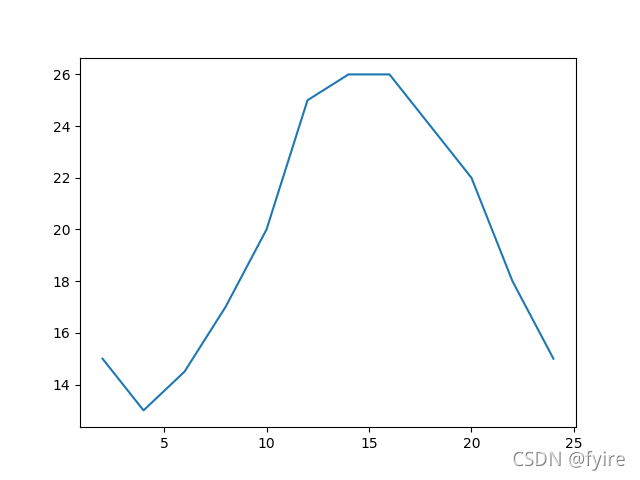
图1
可以看出图像基本绘制出来,只是比较简单。例如x,y轴刻度稀疏,图像没有标题等。
2.1.2 折线图添加属性
图1 比较简单,现在在此基础上添加一些属性。
import matplotlib
from matplotlib import pyplot as plt
# windows和linux设置字体方式
font = {'family': 'MicroSoft YaHei',
'weight': 'bold',
'size': '10.5'}
matplotlib.rc('font', **font)
x = range(2, 26, 2) # 时间
y = [15, 13, 14.5, 17, 20, 25, 26, 26, 24, 22, 18, 15] # 温度
# 设置图像大小
plt.figure(figsize=(20, 8), dpi=80)
# 绘图
plt.plot(x, y, marker="o", mec='r', mfc='w') # 标记为o,边缘为红色,背景是白色
# 重新设定坐标轴刻度
_x = [i // 2 for i in range(49)]
_xticks = ["{}时".format(i) for i in _x]
plt.xticks(_x[::2], _xticks[::2])
plt.yticks(range(min(y), max(y) + 1))
# 书写标题
plt.title("一天的气温变化折线图")
plt.xlabel("时间/时")
plt.ylabel("温度/摄氏度")
# 保存图像
plt.savefig("./test.png")
# 网格
plt.grid(linestyle="-.", alpha=0.3) # 透明度
# 显示图像
plt.show()
得到的图像如下所示:
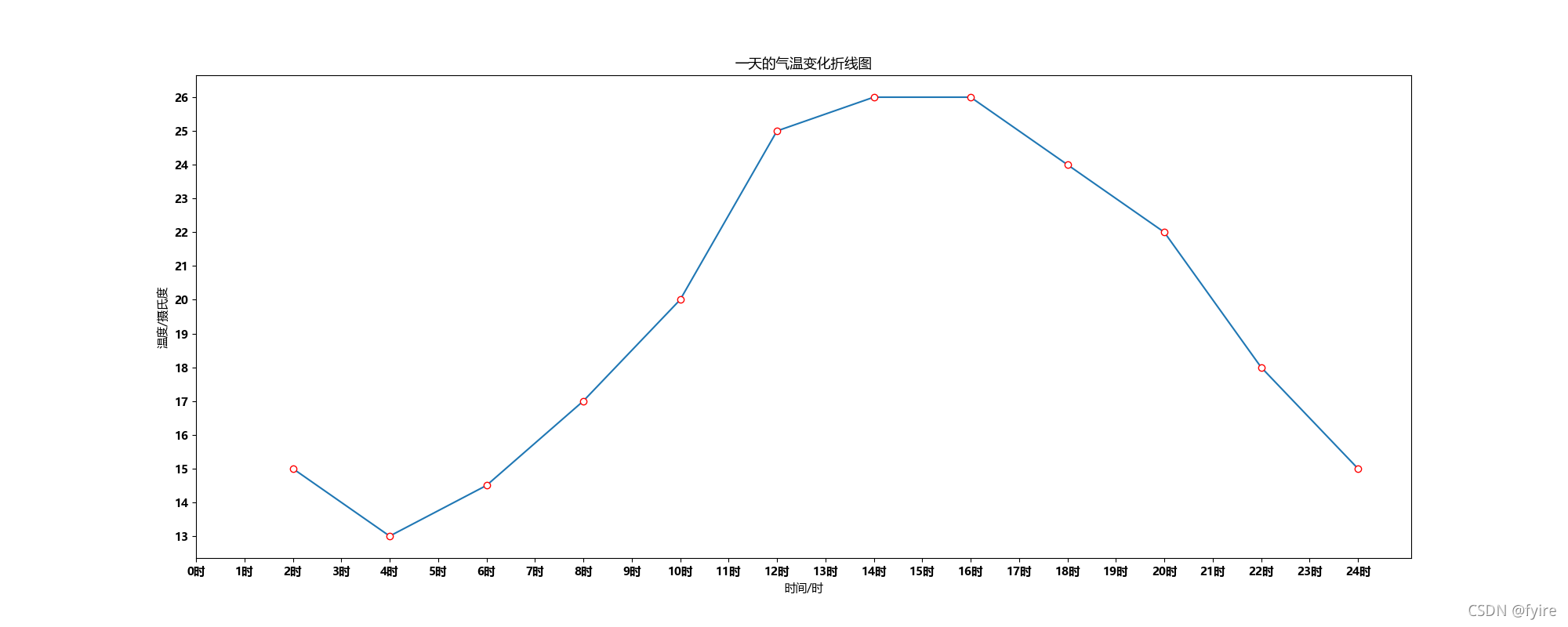
2.2 绘制散点图
例2:假设通过爬虫你获取到了北京2016年3,10月份每天白天的最高气温(分别位于列表a,b),那么此时如何寻找出气温和随时间(天)变化的某种规律? 使用的绘图函数为:scatter(x,y)
import matplotlib
from matplotlib import pyplot as plt
# 设置字体
font = {'family': 'MicroSoft YaHei',
'weight': 'bold',
'size': '10.5'}
matplotlib.rc('font', **font)
# 设置图像大小
plt.figure(figsize=(20, 8), dpi=80)
y_3 = [11, 17, 16, 11, 12, 11, 12, 6, 6, 7, 8, 9, 12, 15, 14, 17, 18, 21, 16, 17, 20, 14, 15, 15, 15, 19, 21, 22, 22,
22, 23]
y_10 = [26, 26, 28, 19, 21, 17, 16, 19, 18, 20, 20, 19, 22, 23, 17, 20, 21, 20, 22, 15, 11, 15, 5, 13, 17, 10, 11, 13,
12, 13, 6]
x_3 = range(1, 32)
x_10 = range(51, 82)
# 绘制散点图
plt.scatter(x_3, y_3, label="3月份")
plt.scatter(x_10, y_10, label="10月份")
# 绘制刻度(刻度只能绘制一次,不能实现叠加)
_x = list(x_3) + list(x_10)
_xticks_label = ["3月{0}".format(i) for i in x_3]
_xticks_label += ["10月{0}".format(i - 50) for i in x_10]
plt.xticks(_x[::3], _xticks_label[::3], rotation=45)
plt.grid(linestyle="-.", alpha=0.3)
# 图例
plt.legend()
plt.title("北京2016年3,10月份白天最高气温")
plt.xlabel("日期(单位:天)")
plt.ylabel("温度(单位:摄氏度)")
# 保存图像
plt.savefig("./test.png")
plt.show()
得到的图像如下所示:
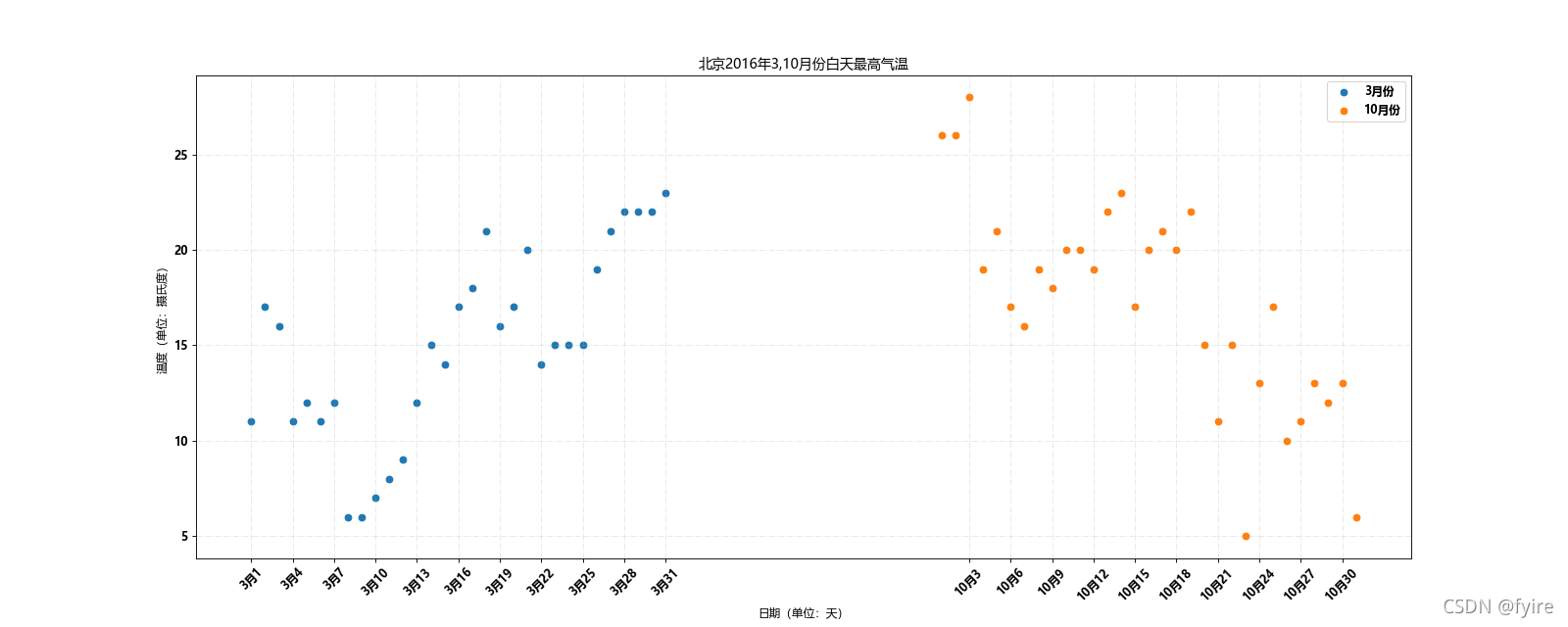
2.3 绘制条形图
2.3.1 绘制单个条形图
例3:假设你获取到了2017年内地电影票房前20的电影(列表a)和电影票房数据(列表b),那么如何更加直观的展示该数据?
a = ["战狼2","速度与激情8","功夫瑜伽","西游伏妖篇","变形金刚5:最后的骑士","摔跤吧!爸爸","加勒比海盗5:死无对证", "金刚:骷髅岛","极限特工:终极回归","生化危机6:终章","乘风破浪","神偷奶爸3","智取威虎山","大闹天竺","金刚狼3:殊死一战", "蜘蛛侠:英雄归来","悟空传","银河护卫队2","情圣","新木乃伊"]
b=56.01,26.94,17.53,16.49,15.45,12.96,11.8,11.61,11.28,11.12,10.49,10.3,8.75,7.55,7.32,6.99,6.88,6.86,6.58,6.23] 单位:亿
from matplotlib import pyplot as plt
import matplotlib
font = {'family': 'MicroSoft YaHei',
'weight': 'bold',
'size': '10.5'}
matplotlib.rc('font', **font)
plt.figure(figsize=(20, 8), dpi=80)
a = ["战狼2", "速度与激情8", "功夫瑜伽", "西游伏妖篇", "变形金刚5:最后的骑士", "摔跤吧!爸爸", "加勒比海盗5:死无对证",
"金刚:骷髅岛", "极限特工:终极回归", "生化危机6:终章", "乘风破浪", "神偷奶爸3", "智取威虎山", "大闹天竺", "金刚狼3:殊死一战",
"蜘蛛侠:英雄归来", "悟空传", "银河护卫队2", "情圣", "新木乃伊"]
b = [56.01, 26.94, 17.53, 16.49, 15.45, 12.96, 11.8, 11.61, 11.28, 11.12, 10.49, 10.3, 8.75, 7.55, 7.32, 6.99, 6.88,
6.86, 6.58, 6.23]
plt.barh(range(len(a)), b, height=0.3, color="orange")
plt.yticks(range(len(a)), a, rotation=30)
plt.title("2017年内地电影票房前20的电影")
plt.ylabel("片名")
plt.xlabel("票房/亿")
plt.grid(alpha=0.3)
plt.show()
得到的图像如下所示:
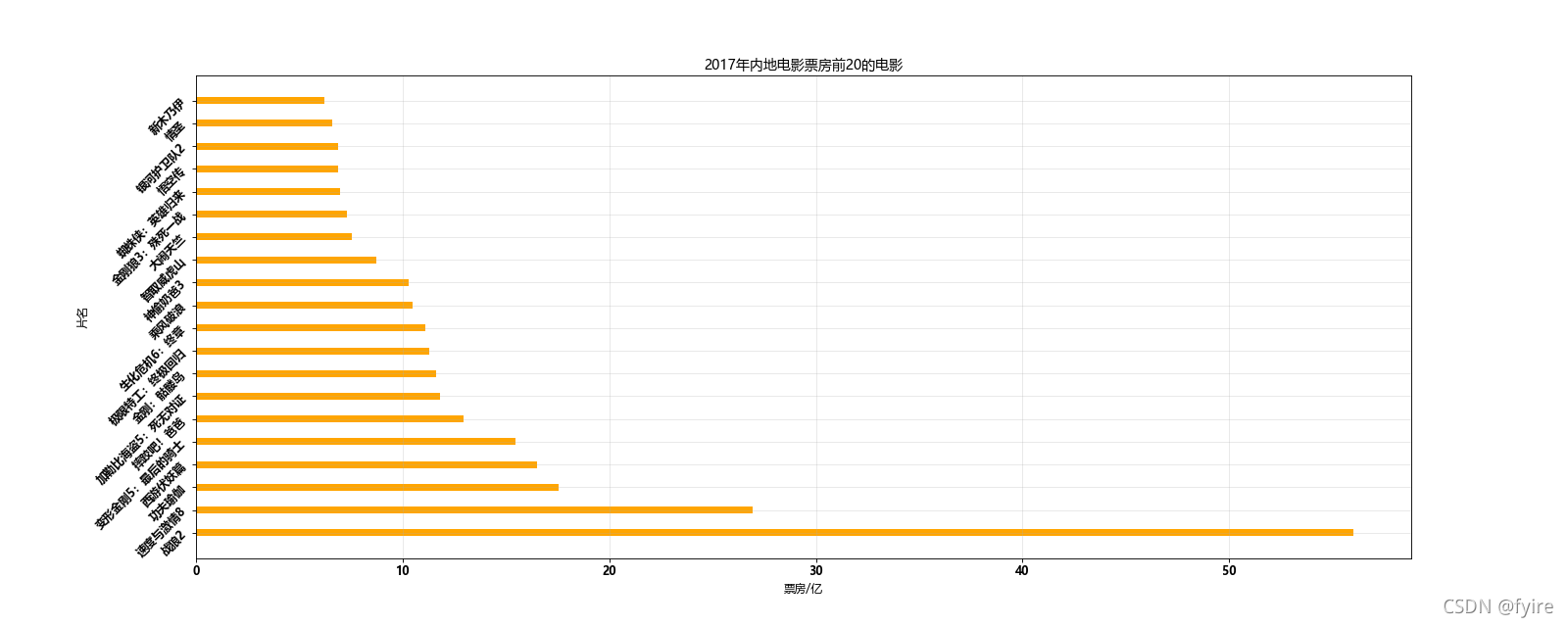
2.3.2 绘制多个条形图
例4:假设你知道了列表a中电影分别在2017-09-14(b_14), 2017-09-15(b_15), 2017-09-16(b_16)三天的票房,为了展示列表中电影本身的票房以及同其他电影的数据对比情况,应该如何更加直观的呈现该数据?
a = ["猩球崛起3:终极之战","敦刻尔克","蜘蛛侠:英雄归来","战狼2"]
b_16 = [15746,312,4497,319]
b_15 = [12357,156,2045,168]
b_14 = [2358,399,2358,362]
from matplotlib import pyplot as plt
import matplotlib
font = {'family': 'MicroSoft YaHei',
'weight': 'bold',
'size': '10.5'}
matplotlib.rc('font', **font)
plt.figure(figsize=(20, 8), dpi=80)
a = ["猩球崛起3:终极之战", "敦刻尔克", "蜘蛛侠:英雄归来", "战狼2"]
b_16 = [15746, 312, 4497, 319]
b_15 = [12357, 156, 2045, 168]
b_14 = [2358, 399, 2358, 362]
x_14 = [x for x in range(len(a))]
x_15 = [x + 0.2 for x in x_14]
x_16 = [x + 0.2 * 2 for x in x_14]
plt.bar(x_14, b_14, width=0.2, label="9月14")
plt.bar(x_15, b_15, width=0.2, label="9月15")
plt.bar(x_16, b_16, width=0.2, label="9月16")
plt.xticks(x_15, a)
plt.xlabel("电影")
plt.ylabel("票房(单位:万元)")
plt.grid(alpha=0.2)
plt.legend()
# 保存图像
plt.savefig("./test.png")
plt.show()
得到的图像如下所示:
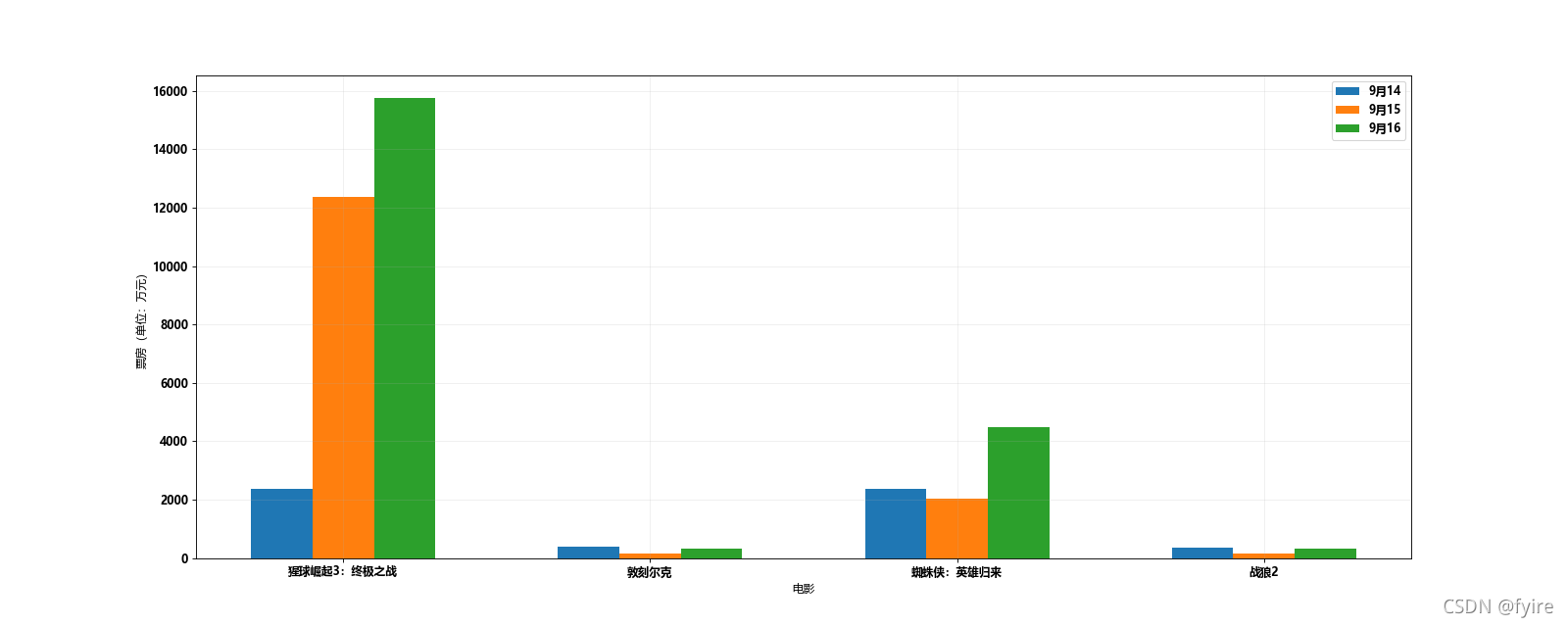
2.4 绘制直方图
例5:假设你获取了250部电影的时长(列表a中),希望统计出这些电影时长的分布状态(比如时长为100分钟到120分钟电影的数量,出现的频率)等信息, 你应该如何呈现这些数据?
a=[131, 98, 125, 131, 124, 139, 131, 117, 128, 108, 135, 138, 131, 102, 107, 114, 119, 128, 121, 142, 127, 130, 124, 101, 110, 116, 117, 110, 128, 128, 115, 99, 136, 126, 134, 95, 138, 117, 111,78, 132, 124, 113, 150, 110, 117, 86, 95, 144, 105, 126, 130,126, 130, 126, 116, 123, 106, 112, 138, 123, 86, 101, 99, 136,123, 117, 119, 105, 137, 123, 128, 125, 104, 109, 134, 125, 127,105, 120, 107, 129, 116, 108, 132, 103, 136, 118, 102, 120, 114,105, 115, 132, 145, 119, 121, 112, 139, 125, 138, 109, 132, 134,156, 106, 117, 127, 144, 139, 139, 119, 140, 83, 110, 102,123,107, 143, 115, 136, 118, 139, 123, 112, 118, 125, 109, 119, 133,112, 114, 122, 109, 106, 123, 116, 131, 127, 115, 118, 112, 135, 115, 146, 137, 116, 103, 144, 83, 123, 111, 110, 111, 100, 154,136, 100, 118, 119, 133, 134, 106, 129, 126, 110, 111, 109, 141,120, 117, 106, 149, 122, 122, 110, 118, 127, 121, 114, 125, 126,114, 140, 103, 130, 141, 117, 106, 114, 121, 114, 133, 137, 92,121, 112, 146, 97, 137, 105, 98, 117, 112, 81, 97, 139, 113,134, 106, 144, 110, 137, 137, 111, 104, 117, 100, 111, 101, 110,105, 129, 137, 112, 120, 113, 133, 112, 83, 94, 146, 133, 101,131, 116, 111, 84, 137, 115, 122, 106, 144, 109, 123, 116, 111,111, 133, 150]
from matplotlib import pyplot as plt
import matplotlib
font = {'family': 'MicroSoft YaHei',
'weight': 'bold',
'size': '10.5'}
matplotlib.rc('font', **font)
plt.figure(figsize=(20, 8), dpi=80)
a = [131, 98, 125, 131, 124, 139, 131, 117, 128, 108, 135, 138, 131, 102, 107, 114, 119, 128, 121, 142, 127, 130, 124,
101, 110, 116, 117, 110, 128, 128, 115, 99, 136, 126, 134, 95, 138, 117, 111, 78, 132, 124, 113, 150, 110, 117, 86,
95, 144, 105, 126, 130, 126, 130, 126, 116, 123, 106, 112, 138, 123, 86, 101, 99, 136, 123, 117, 119, 105, 137,
123, 128, 125, 104, 109, 134, 125, 127, 105, 120, 107, 129, 116, 108, 132, 103, 136, 118, 102, 120, 114, 105, 115,
132, 145, 119, 121, 112, 139, 125, 138, 109, 132, 134, 156, 106, 117, 127, 144, 139, 139, 119, 140, 83, 110, 102,
123, 107, 143, 115, 136, 118, 139, 123, 112, 118, 125, 109, 119, 133, 112, 114, 122, 109, 106, 123, 116, 131, 127,
115, 118, 112, 135, 115, 146, 137, 116, 103, 144, 83, 123, 111, 110, 111, 100, 154, 136, 100, 118, 119, 133, 134,
106, 129, 126, 110, 111, 109, 141, 120, 117, 106, 149, 122, 122, 110, 118, 127, 121, 114, 125, 126, 114, 140, 103,
130, 141, 117, 106, 114, 121, 114, 133, 137, 92, 121, 112, 146, 97, 137, 105, 98, 117, 112, 81, 97, 139, 113, 134,
106, 144, 110, 137, 137, 111, 104, 117, 100, 111, 101, 110, 105, 129, 137, 112, 120, 113, 133, 112, 83, 94, 146,
133, 101, 131, 116, 111, 84, 137, 115, 122, 106, 144, 109, 123, 116, 111, 111, 133, 150]
# 画直方图
bin_width = 3 # 设置直方图宽
num_bins = int((max(a) - min(a)) / bin_width) # 直方图数目
plt.hist(a, num_bins)
plt.xticks(list(range(min(a), max(a)))[::3], rotation=45)
plt.xlabel("电影时长(单位:分钟)")
plt.ylabel("数量")
plt.grid(linestyle="-.", alpha=0.2)
plt.show()
得到的图像如下所示:
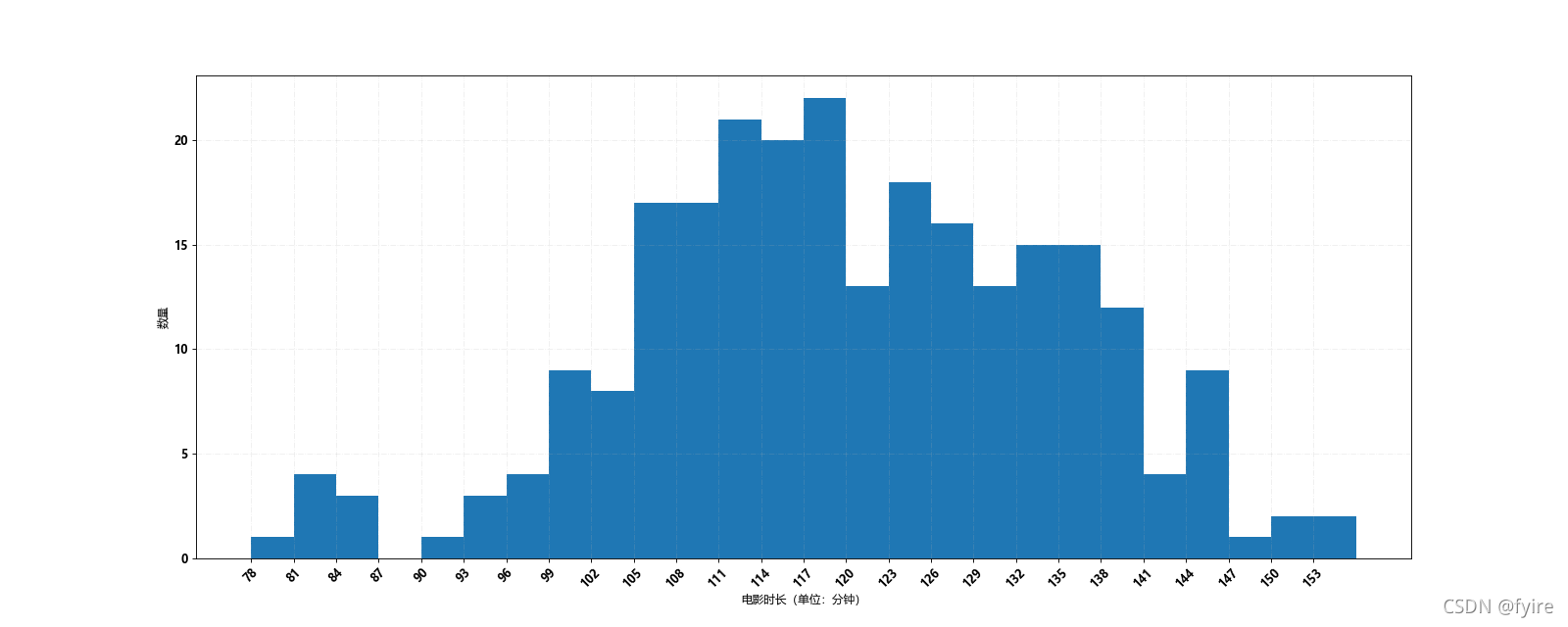
总结:至此,4中常见图像的绘制展示完毕。以上例题来自学习资料,不对之处可以指出。








 本文详细介绍了使用Python的matplotlib库进行折线图、散点图、条形图和直方图的绘制,包括基本操作和高级定制,适用于数据可视化和理解趋势。
本文详细介绍了使用Python的matplotlib库进行折线图、散点图、条形图和直方图的绘制,包括基本操作和高级定制,适用于数据可视化和理解趋势。
















 5300
5300

 被折叠的 条评论
为什么被折叠?
被折叠的 条评论
为什么被折叠?








